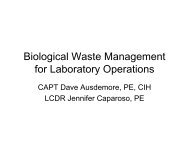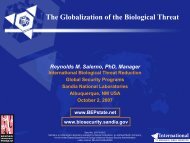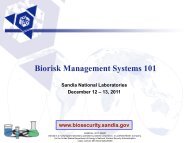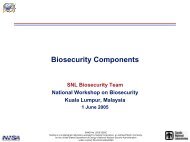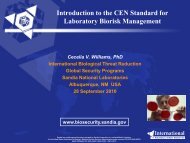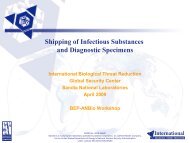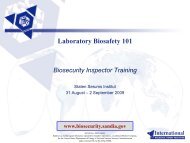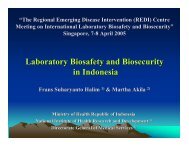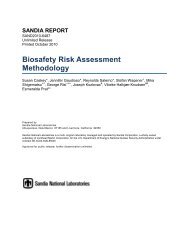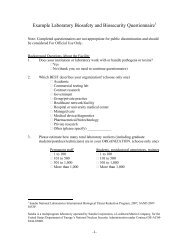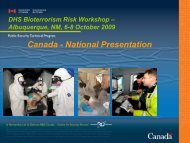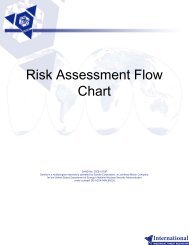The Infectious Disease Threat and Laboratory Biosafety - Sandia ...
The Infectious Disease Threat and Laboratory Biosafety - Sandia ...
The Infectious Disease Threat and Laboratory Biosafety - Sandia ...
You also want an ePaper? Increase the reach of your titles
YUMPU automatically turns print PDFs into web optimized ePapers that Google loves.
<strong>The</strong> <strong>Infectious</strong> <strong>Disease</strong> <strong>Threat</strong> <strong>and</strong><strong>Laboratory</strong> <strong>Biosafety</strong>SNL Biosecurity TeamNational Workshop on BiosecurityKuala Lumpur, Malaysia31 May 20052005- p/1SAND No. 2005-3346CS<strong>and</strong>ia is a multiprogram laboratory operated by S<strong>and</strong>ia Corporation, a Lockheed Martin Company,for the United States Department of Energy’s National Nuclear Security Administrationunder contract DE-AC04-94AL85000.
<strong>The</strong> <strong>Infectious</strong> <strong>Disease</strong> <strong>Threat</strong>• Recent outbreaks of emerging infectious diseaseawakened the international community to threats topublic <strong>and</strong> agricultural health• Most threat mitigation strategies have focused onoutbreak management• Measures must also be developed to preventoutbreaks of highly infectious disease• <strong>Laboratory</strong> biosafety is one aspect of the solution• Ensures the safety <strong>and</strong> well being of workers in thelaboratory• Safeguards public <strong>and</strong> agricultural health bypreventing the accidental release of harmfulbiological agentsToday, the infectious disease threat is a globalproblem that requires global solutions2005- p/2
Severe Acute Respiratory Syndrome(SARS)• In 2003, SARS infected over 8,000 people<strong>and</strong> killed almost 800• <strong>The</strong> disease ravaged economies in thePacific Rim <strong>and</strong> Canada <strong>and</strong> struck fearacross the globe• <strong>Laboratory</strong> acquired SARS outbreaksoccurred in Singapore, Taiwan, <strong>and</strong>mainl<strong>and</strong> China• Singapore—September 2003• Taiwan (China)—December 2003• Beijing <strong>and</strong> Anhui (China)—March 20042005- p/3
<strong>Laboratory</strong>-Acquired Case of SARSSingapore, September 2003• Patient: 27-year-old male graduate student• Place of infection: BSL-3 laboratory, Environmental HealthInstitute• Onset of illness: August 26, 2003• Hospitalization: September 3, 2003• Confirmed day: September 8, 20032005- p/4
Summary of the WHO Investigation, Singapore• <strong>The</strong> graduate student acquired the infection in the BSL-3laboratory in the Environmental Health Institute where heworked• Inappropriate laboratory procedures <strong>and</strong> a crosscontaminationof West Nile virus samples with SARS-CoV inthe laboratory led to the infection• No evidence could be found of any other source of infection• Isolated event: no evidence of secondary transmission2005- p/5
<strong>Laboratory</strong>-Acquired Case of SARSTaiwan (China), December 2003• Patient: 44-year-old male laboratory scientist• Place of infection: BSL-4 laboratory, Institute ofPreventative Medicine (IPM), National Defense MedicalCenter (NDMC)• Onset of illness: December 11, 2003• Hospitalization: December 16, 2003• Confirmed day: December 17, 20032005- p/6
Summary of WHO Investigation, Taiwan (China)• Scientist was working on SARS-CoV in a BSL-4 facility atthe IPM-NDMC• He found a spillage of material in the transportationchamber <strong>and</strong> disinfected it with 70% ethanol <strong>and</strong> cleaned itmanually• <strong>The</strong> environment specimens collected from the h<strong>and</strong>le of analcohol spray bottle from the transportation chamber <strong>and</strong>the switch panel of the cabinet yielded positive results forSARS-CoV• Isolated event: no evidence of secondary transmission2005- p/7
<strong>Laboratory</strong>-Acquired SARS Outbreakin China, March-April 2004• Occurred in Beijing <strong>and</strong> Anhui Province,linked to the National Institute of Virology,China CDC• <strong>The</strong> source of the outbreak was failed orincomplete inactivation of SARS-CoV(cold inactivation)• Involved two verified chains of SARS-CoV transmission• Three generations, resulting in 9 cases• Serological analysis on the laboratory staff revealed threemore seroconverted cases <strong>and</strong> one of them is most likely tohave been infected early in February 20042005- p/8
<strong>Laboratory</strong>-Acquired SARS Outbreakin China, March-April 2004•A (female research student) 25 MarchChina CDC2ndB (A's mother)deathC (nurse attending A)3rdD(C's mother)E(C's aunt)F(C's father)G (retired doctor sharing hospital room with C)H(G's daughter-in-law)• I (male laboratory researcher) 17 AprilSARS IgG (+)J (female laboratory worker in BSL-3 laboratory)K (female laboratory worker developed pneumonia)L (male laboratory worker, A's supervisor)2005- p/9
Common Problems• Bad practice in laboratory management• Poor supervision of less experienced professionals• A lack of accountability for occupational health <strong>and</strong> safety• A lack of biosafety policy• A lack of biosafety procedures <strong>and</strong> staff training inbiosafety practice• A lack of internal <strong>and</strong> external quality assurance2005- p/10
Highly Pathogenic Avian Influenza• Millions of poultry culled in response tooutbreaks in South East Asia• Over 50 humans dead since late 2003,elevated mortality rates• Experts fear that if human-to-humantransmission becomes more efficient, ap<strong>and</strong>emic looms• Push to construct clinical <strong>and</strong>diagnostic laboratories for H5N1throughout Southeast Asia• Imperative to establish sound biosafetypractices• To prevent accidental release of thevirus• To minimize workers becoming infected,providing opportunities for virusadaptation to humansAvian influenza virus2005- p/11
Nipah• 1999 Outbreak in Malaysia killed 105people <strong>and</strong> thous<strong>and</strong>s of pigs• Over 900,000 pigs culled• FAO estimates total cost close to$450 million• Concern that the Nipah virus couldmutate to a more deadly form• Potential to devastate agriculturalindustries worldwideNipah virus in pig lung2005- p/12
Polio• <strong>The</strong> debilitating childhood diseasecontinues to plague developing countries• Currently being tackled by WHO’s GlobalPolio Eradication Initiative• Vaccination remains the only effectiveeradication method• Recent re-emergence of polio inIndonesia, Yemen• Imperative to prevent re-establishment incountries where the disease has beeneradicated• <strong>Laboratory</strong> <strong>Biosafety</strong> practices contributeto this goal2005- p/13
<strong>Laboratory</strong> <strong>Biosafety</strong>• Provides a means to reduce outbreaks ofhighly infectious diseases• WHO biosafety:• “<strong>Laboratory</strong> biosafety” describescontainment principles, technologies,<strong>and</strong> practices implemented to preventunintentional exposure to pathogens <strong>and</strong>toxins, or their accidental release• Achieving biosafety• Important to develop national biosafetypolicies• Critical to develop a culture of biosafety<strong>Laboratory</strong> <strong>Biosafety</strong> Manual,3 rd Edition2005- p/14
2005- p/15
Conclusions• <strong>Infectious</strong> diseases pose significant threats to public <strong>and</strong>agricultural health• Research on harmful biological agents is crucial to mitigatethe threat• However, release <strong>and</strong> theft of biological agents must beavoided• Imperative to protect public <strong>and</strong> agricultural health, <strong>and</strong>safeguard laboratory workers• Managing risks in the laboratory is dependent on bothbiosafety <strong>and</strong> biosecurity• Helps reduce the threat of infectious disease2005- p/16



